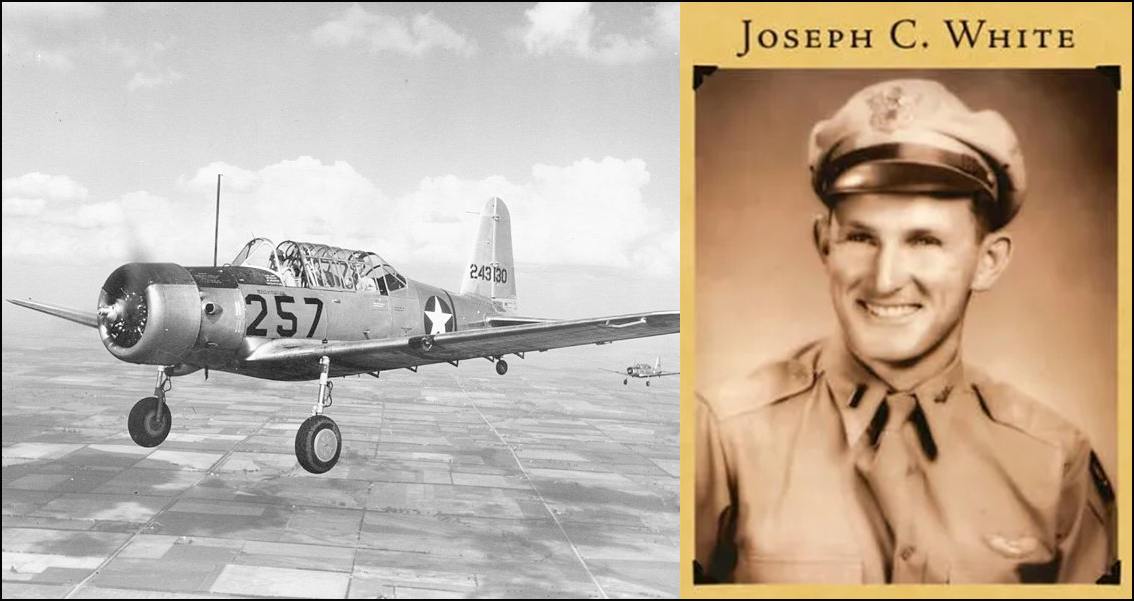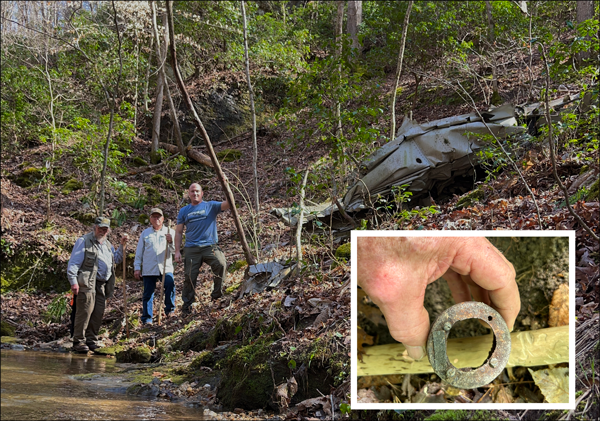 Genealogy can touch our lives in many ways as we discover and share the treasured stories of our ancestors. One of these stories from our Paulding community is an old legend that has been discussed here at the Paulding County Genealogical Society (PCGS) for decades. It’s the story of a mysterious plane crash that happened somewhere in the wooded hills of Paulding County long ago, presumably during WWII. Witnesses of the original crash site, Mr. Felt Cochran and Mr. Jewel Graham, passed down stories of what they saw to family and friends but as time passed, the details of their account became blurry. In the early 1970’s, Mr. Cochran led his son, Homer Cochran, and nephew, Jon Tripcony, back to the crash site and showed them the wreckage of the forgotten plane. Jewel Graham’s sons and wife, Sammy, Bobby, and Jeanette Hutcheson Graham, can still remember Jewel discussing the crash but this was long ago. As time passed by, stories of this old WWII plane crash were mentioned less frequently around town. Nobody seemed to know why the plane crashed or who was the pilot or what this military plane was doing while flying above Paulding County during WWII? A few citizens thought the plane was on a secret mission and details of the event had purposely been hushed by the military. Occasionally, a random deer hunter would unexpectedly stumble across the plane wreckage and rumors of the crash would surface again. Maybe a dozen locals could remember hearing about the plane crash but not a single person could explain the history or the fate of this military plane. By the turn of the century, this local aviation disaster was almost forgotten.
Genealogy can touch our lives in many ways as we discover and share the treasured stories of our ancestors. One of these stories from our Paulding community is an old legend that has been discussed here at the Paulding County Genealogical Society (PCGS) for decades. It’s the story of a mysterious plane crash that happened somewhere in the wooded hills of Paulding County long ago, presumably during WWII. Witnesses of the original crash site, Mr. Felt Cochran and Mr. Jewel Graham, passed down stories of what they saw to family and friends but as time passed, the details of their account became blurry. In the early 1970’s, Mr. Cochran led his son, Homer Cochran, and nephew, Jon Tripcony, back to the crash site and showed them the wreckage of the forgotten plane. Jewel Graham’s sons and wife, Sammy, Bobby, and Jeanette Hutcheson Graham, can still remember Jewel discussing the crash but this was long ago. As time passed by, stories of this old WWII plane crash were mentioned less frequently around town. Nobody seemed to know why the plane crashed or who was the pilot or what this military plane was doing while flying above Paulding County during WWII? A few citizens thought the plane was on a secret mission and details of the event had purposely been hushed by the military. Occasionally, a random deer hunter would unexpectedly stumble across the plane wreckage and rumors of the crash would surface again. Maybe a dozen locals could remember hearing about the plane crash but not a single person could explain the history or the fate of this military plane. By the turn of the century, this local aviation disaster was almost forgotten.
It wasn’t until 2014 when three amateur historians of the Paulding County Genealogical Society, Sammy Graham, Phil Pearce, and the late Wayne Gurley began discussing the old plane crash and a mutual interest was found with a determination to find out more about the history of the plane. Their excitement to find the plane quickly roped in others who shared the same enthusiasm but their efforts were dashed as details about the plane crash seemed nearly impossible to find. Many of the locals who saw the crash site firsthand had already passed away. Research through newspapers, military records, and history books mentioned nothing about a plane crash like this in Paulding County that could be related to WWII. As months and then years passed by, their research produced little and the old plane crash story was shelved again. In 2021, the Paulding County Genealogical Society was revisiting previously paused research projects when the plane crash folder was reopened. Some new leads were discovered as other members such as Shelly Sidhu and Brian Cochran contributed by digging deep into records with a determination to find the crash. Everyone tapped into their local networks of friends who might know more and they scoured over maps while trying to pinpoint the rumored location of the crash. Sadly, Mr. Wayne Gurley unexpectedly passed away as the crash investigation was pushing forward. The research efforts hit a lull and the trail to the old plane was lost once again. By this point, the research team felt confident they had determined the location of the crash site but this did little to explain the full story. Finally, the PCGS agreed to pause the investigation until an expedition to the crash site could be planned with hopes that debris from the wreckage might share more clues.
Time passed and the old plane crash story was mentioned occasionally but other projects seemed more pressing; forgotten cemeteries, genealogical mysteries, and preserving the history of other local events would take precedence over the plane crash legend. It was early 2024 when the Genealogical Society reopened the project once again. The presumed location of the crash site was in a remote section of the Paulding Forest Wildlife Management Area. This meant the timing of the expedition would need to be planned outside of seasonal activities such as deer hunting and it’s known that bushwhacking through these isolated mountains is more suitable in the winter time to avoid the rattlesnakes. Also, it was necessary to gain permission from private land owners before journeying across their properties. Navigating with few details other than fragments of stories that had been handed down decades ago, Sammy Graham, Jon Tripcony, and Brian Cochran set out on a mission into the forest with hopes of finding the plane. Tripcony designated some possible coordinates for the crash site after consulting with Homer Cochran who visited the crash site with his father as a kid. With a destination on the map, the crew made a nearly direct route to the crash site. Arriving at the location, they quickly discovered a large engine! Clearly, it must be the engine of the old plane that crashed here nearly 80 years ago! The excitement was overwhelming! The crew immediately began searching across the surrounding area for more debris and in minutes, they discovered what appeared to be one of the wings or possibly the fuselage of the old plane. Time was limited so they quickly assessed the crash site, they made notes of items they located, logged in their coordinates, and agreed to return for a more thorough study sometime soon. The old crash site had finally been rediscovered. The old story about a military plane crash had been revived!
The next few weeks were hectic. Members of the society who were researching the wreckage spent days online while looking for more details about the crash. They would meet at the PCGS Research Library to compare notes and ideas. Phone calls, text messages and emails were an everyday thing. The large engine that was abandoned in the forest was the only concrete piece of evidence that could be used to find links to the plane crash; this proved to be difficult. Their research produced a variety of different engine types, plane models, wing styles, propeller types, and more to consider but nothing was guaranteed and nothing provided a direct link to the Paulding County plane. They cross-referenced one another and the research seemed endless… but nothing! Thousands of reports about military plane crashes had been scanned but none of them even slightly mentioned a military plane crash in Paulding County during WWII. After weeks of exhausting research, it was agreed that a second expedition to the crash site was required. Everyone believed a meticulous study of the wreckage could possibly reveal enough information to positively identify the model of the plane. If specific serial numbers or model numbers on the wreckage were discovered, these clues would also be used in the investigation.
The second mission to the crash site was led by Sammy Graham, a longtime member of the PCGS. Sammy took along his grandsons, Nick and Christopher Hensley, who are also members of the society. Christopher was especially interested in the research because he is leaving out for basic training for the US Air Force on April 22, 2024. This second expedition lasted nearly an entire day and would prove to be extraordinary. After quickly becoming familiar with the crash site terrain, Sammy and his grandsons were able to discover a large amount of debris from the plane. Each item was examined for numbers or other characteristics that might help with the investigation. Items that seemed promising were photographed. Just before wrapping up the study, Mr. Sammy Graham stopped to analyze one last piece he spotted on the ground. It was a small circular piece of rusted metal with 4 small screws and a tiny metal tag. The numbers on the corroded tag were hardly legible to the naked eye but Sammy thought wisely and captured a zoomed-in photo of the tag before leaving. The photo of this metal tag attached to an eighty-year-old piece of rusted metal would soon be relayed to another member of the PCGS. Few people could imagine what this 3/4” inch rusted tag would teach us.
Photos of the evidence discovered at the crash site were shared and everyone imagined how certain parts of the plane might possible fit together with the crash. Unfortunately, as before, there was not a smoking gun… but, there was that tiny little rusty tag. After close examination of the tag, the team was able to identify a few numbers but early searches online didn’t produce any good results. It was a few days later when a member of the team, Brian Cochran, uploaded images of this tag to a program for a magnified view of the writing. Brian used a trial and error approach for predicting what was originally stamped on the tag. Hours were spent with different searches with different numbers through different data bases until finally it happened! There was a solid hit that matched the numbers from the rusty tag to a military plane and it was a World War II plane! Sammy Graham had initially suggested that the round metal piece with the little tag was possibly a gauge and this is what popped up on the computer screen for Brian. In minutes, Brian found an image online of an entire gauge cluster from the cockpit of a WWII military plane known as the Vultee BT-13A Valiant. This was promising. This simple tag had apparently just identified a style of plane that had not been previously on the research team’s radar. Searches with this plane model generated thousands, yes, thousands of military crash reports from across the nation related to the B-13A Valiant. There were big crashes, little crashes, unexplainable crashes, easily explained crashes, deadly crashes, pilot ejected crashes, landing crashes, midair disasters, pilot error crashes, engine fire crashes, out of gas crashes, etc. It was hours later when a search through the Aviation Safety Network database produced a crash report with Dallas, Georgia as the location. This was the plane! This was the story that families and friends have shared for almost 80 years. The story is not forgotten.
Report: USAAF and Allied Forces Non Combat Losses and Incidents: On Thursday, May 18th of 1944 a military plane known as the Vultee BT-13A Valiant crashed in Dallas, Georgia. The pilot, Joseph C White, bailed out of the plane and survived.
The crash report was discovered on an open-source search engine that holds a database of military aviation disasters. Similar reports in other databases were used to support the findings. The details in reports of this nature are often vague so the PCGS was now tasked with identifying more info about the actual pilot. Researchers, Shelly Sidhu, Phil Pearce, Sammy Graham, and Brian Cochran, led the chase by making connections across the country in search of this man. The PCGS was determined to discover more and preserve his story! In the early stages, it was quickly learned that the US military has dozens of Joseph C. White veterans which led to lots of unanswered questions and dead-ends… But, the teamwork paid off. The cohesiveness of the team slowly allowed them to zero in on one particular Joseph C. White who seemed to match. They soon discovered that after leaving the military, this Mr. White would later write a few books about his journey through life. In one of his books, this Mr. White tells us what unfolded on a day when the engine of his plane completely stopped as he was flying over the wooded hills of Paulding County, way back in 1944.
From the book, “A Poor Boy’s Odyssey,” by Mr. Joe White…
“I was on a scheduled cross-country flight to Atlanta and my engine quit. I was over a wooded area with no place to make a forced landing. Rather than crash-land among the trees and rocks, I used my parachute and got out. I opened the canopy, turned the plane upside down, and unbuckled my seat belt, which was how I had been taught to do it. With the plane upside down, that was intended to let me fall out of the airplane straight down.
The canopy of a BT-13A can be latched in five different positions, sliding from front to back: fully closed, 1/4 open, 1/2 open, 3/4 open, and fully open. When I opened it to bail out, it accidentally latched into the 3/4 open position instead of fully open, and after I fell about a foot, my parachute harness hung on the canopy and held me in the plane. I had fallen far enough that I couldn't reach the control stick, so I put my foot against it and shoved it forward. Since the plane was upside down, that raised the nose enough to dislodge my parachute and let me fall out the plane. I pulled the ripcord, the parachute opened, and before I knew it I was sitting on a big branch of a tall pine tree with both arms around the trunk.
I hadn't seen a house anywhere nearby, but very soon people began showing up at the site. Someone gave me a ride to Atlanta, and I called Newport and told them what had happened. Lt. Col. Brown flew down the next day and gave me a ride back to the base, and we flew past the crash site so he could see the situation. He agreed there was no place for landing. They had an inquiry when I got back and asked me a lot of questions, but they cleared me of any blame.”
As our research proceeds, the Paulding County Genealogical Society is excited to learn and share more about the man who left such a legacy for our community. The Genealogical Society is currently conducting interviews with the surviving family members of the pilot, Mr. Joseph C. White, and gathering more information about this extraordinary event. We look forward to an upcoming presentation for the summer of 2024 in which we will discuss this project in greater detail. We encourage members of our Paulding community to share your story too if you’ve heard rumors of this plane crash from family or friends. Visit us at the PCGS Research Library or give us a call to hear more about this ongoing research project and other exciting things happening within the society.



















